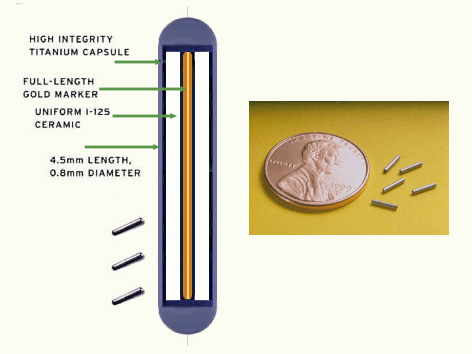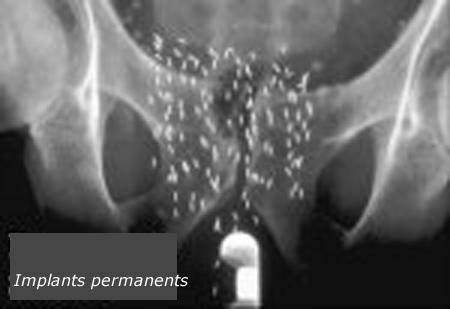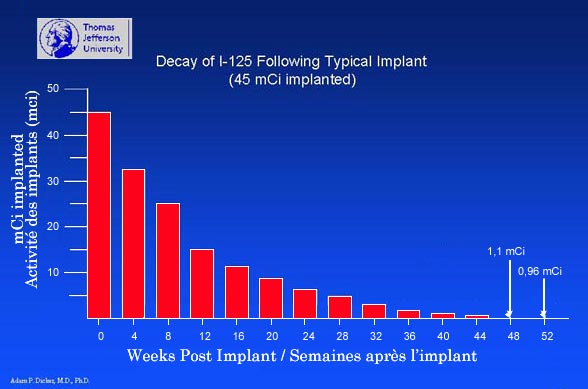An Efficient destruction of cancerous cells
Since the 2000s, particularly in the United States and Europe, brachytherapy has been used for the treatment of prostate cancers. Prostate brachytherapy consists in installing radioactive implants in this gland made of a radioactive source coated in a titanium capsule. Two artificial radioelements are used, iodine-125 and palladium-103.

Implants for prostate brachytherapies
Implants have the size of a grain of rice. Two artificial radioelements are used, iodine-125 (I-125) and palladium-123 (Pd-103). These two radioisotopes emit low energy electrons and X-Rays. The electrons are not energetic enough to come out of the implants. The irradiation is due to X-rays which are mainly absorbed in the “prostate” tissues surrounding the implant.
© Kimmel Cancer Center at Jefferson.
Why these two radioelements? They have in common to decay through electron capture, a rare mode of disintegration which deposits little energy in the medium (The decay energy is mainly carried away by a neutrino, a particle that leaves no trace in the body of the patient!). Electrons (conversion electrons, Auger electrons and X-rays are emitted during the rearrangement of the atom following the capture.
Electrons, whose energy is lower than that of normal beta electrons, are absorbed by the walls of the capsule. The energy deposit in the organism is only due to these X-rays: 20 keV on average per disintegration. In this energy range, the average path of X-rays in living matter is only a few cm. For this reason, most of the energy deposited in the body is deposited in the prostate or in its immediate vicinity. This explains why one can keep these implants while in other brachytherapies the sources are only kept for the duration of hospitalization.

Prostate brachytherapy
Iodine 125 sealed sources (period of 60 days) are used in brachytherapy for prostate cancer. The sources, a few millimeters long, are installed in the patient’s prostate. They have a unit activity of between 10 and 25 MBq and a treatment requires approximately one hundred grains representing a total activity of 1500 MBq, making it possible to deliver a prescribed dose of 145 Gray to the prostate.
© Kimmel Cancer Center at Jefferson
From 40 to 130 implants are installed in the prostate, the number being determined by the volume of the prostate to be treated. These implants remain. However, they completely lose their radioactivity after a certan time: the iodine-125 implants after about 6 months, those of palladium-103 about 3 months.
The speed with which the radioactivity goes down turning radioactive atoms into non-radioactive atoms is determined by the half-life or period: 60.5 days for iodine-125 and 17.7 days for palladium-103. In order to deliver the same amount of radiation to cancer cells, the activity of palladium implants is initially chosen to be higher than with iodine, the duration of irradiation being shorter.

Evolution of iodine-125 implants activity
The radioactivity of the implants with its number of radioactive atoms decrease with a rapidity which is determined by its half-life (period) : 60.5 days for iodine-125 and 17.7 days for palladium-103. The bulk of the implants activity disappeared after a few periods, 87.5% after 3 periods, 98.4% after 6 periods, etc … The decay of palladium is 3 times faster. In six months it has disappeared. It is the question of dose rate adapted to the patient’s condition and his age, which determines the choice of one or the other radioisotope.
© Source Kimmel Cancer Center at Jefferson/Adam.P.Dicke
Most of the radiation emitted by odine-125 or palladium-103 is absorbed in the gland to be treated. A smalle fraction nevertheless affects nearby structures such as the rectum. In addition to this legitimate concern for the patient, there is a risk for those around him as long as the radioactivity has not diminished sufficiently: the patient is himself slightly radioactive: A fraction of gamma or X rays emitted can also emerge from his body, due to their penetrating nature.
The level of radiation emerging after installation of the implants remains however at a level deemed not to be dangerous for those around him, but a few precautions can reduce the risk. Prolonged contact with pregnant women or with young children (such as holding them on the knees) should be avoided for the 3 to 6 months it takes for the radioactivity to disappear, but a hug, a kiss, or handshake become perfectly safe.
Other articles on the subject « Radiation Therapy »
Radiotherapies
X-rays but no radioactivity Radiotherapy today denotes all cancer treatments based on ionizing ra[...]
Metabolic Therapies
Therapeutic Radioisotopes Applications of radioisotopes in nuclear medicine are not limited to sc[...]
Brachytherapies
The oldest nuclear therapy modernized today Brachytherapies (or Curietherapies) are the oldest th[...]
Protontherapies
Proton therapy: an advanced and precise radiotherapy Proton therapy involves treating tumors with[...]
Secondary Risks
Alternative: exposure to radiation or let the cancer evolve… For over 20 years, there has b[...]